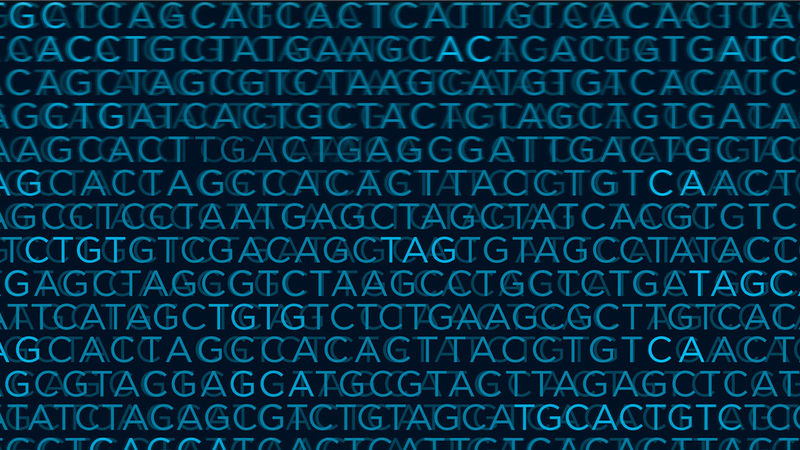In September 2002, doctors reported that actor Christopher Reeve could wiggle his fingers and toes. For the man who four times depicted Superman on the silver screen — and whose spinal cord had been severed in a 1995 equestrian accident — the announcement was evidence of perhaps the most superhuman feat imaginable: the regeneration of a catastrophically damaged central nervous system.
Unlike our muscles and bones, the components of the human nervous system generally can’t knit themselves back together once we leave the womb. That’s what was so extraordinary about Reeve’s ever-so-slight ability to control his digits. Somehow, over the course of seven years and thousands of hours of physical therapy, his 50-year-old central nervous system had begun to repair itself.
Such healing is the holy grail of regenerative medicine, a field intent on redeploying the intricate biochemical programming that spurs growth and development in the womb to repair the insults and injuries of life on the outside. Unfortunately, scientists still don’t fully understand how neural development comes about during gestation, so they can’t replicate it to repair spinal-cord injuries or reverse degenerative diseases like multiple sclerosis.
The key, says Notre Dame cell biologist Cody Smith, involves figuring out how the embryonic cells that give rise to the neural system communicate with one another. “Usually that communication is done with proteins, which are generated by RNA, which comes from DNA,” says Smith, the Elizabeth and Michael Gallagher assistant professor of biological sciences. “By identifying the proteins used by the cells to communicate, we hope to have a better idea of what types of drugs or therapies would be useful in both development and regeneration disorders.”
Smith doesn’t work directly with human tissues. Instead, he and his research team use zebrafish — a small, tropical species that reaches maturity in just 90 days — as a model to explore the cascade of interactions by which developing organisms transform a single fertilized egg into the millions of specialized cells that comprise a fully functioning neural network. As with human and mouse DNA, scientists have fully sequenced the zebrafish genome and developed a database that ties specific zebrafish genes to the traits they induce. By perturbing portions of the genes that direct neural development and communication, Smith and his team at Notre Dame’s Center for Stem Cells and Regenerative Medicine are uncovering leverage points for repair and recovery.
Historically, the process of developing genetically tailored animal models of human function and dysfunction has been an expensive, meticulous process that combines technical expertise, years of specimen breeding and a high error rate. Yet over the past six years, a biochemical tool known as CRISPR has transformed the field of gene editing. In Smith’s laboratory and hundreds of others around the globe, the comparatively fast, affordable and precise process has put genetic manipulation within reach of a new generation of scientific investigators.
- The Promise and Peril of Technology
- Too Smart for Our Own Good?
- Cut and Paste
- Welcome to the Intermind
Pronounced like the name of the refrigerator drawer where you stash fresh veggies, CRISPR exploits a gene-editing technique used for millennia by microbes in the natural world. First reported in a leading scientific journal in 2012, the laboratory version lets scientists rearrange specific sequences of molecules among the billions that program activity within a living organism, then watch how their changes play out over time. Target just the right sequences, the thinking goes, and solutions are sure to emerge for major global problems in health care, the environment and food production. Refined for clinical applications, CRISPR might one day help doctors eliminate the symptoms of genetically inherited disorders like cystic fibrosis, hemophilia and muscular dystrophy, and potentially cure conditions like cancer, heart disease and mental illness. In the United States, Europe and China, investigators have begun laying the groundwork for CRISPR-powered clinical trials for sickle cell anemia, beta thalassemia and leukemia. Several are already recruiting participants.
With scientists around the world experimenting with CRISPR to modify human embryonic stem cells to answer questions about basic biology and development, the prospect of human genetic engineering would seem to loom on the distant, not-yet-technically feasible horizon. Screenwriters are already making the most of such possibilities. Designer babies and other dystopian hazards fuel the drama in Netflix’s Luke Cage and in C.R.I.S.P.R., Jennifer Lopez’s bioterror procedural under development, in which a scientist thwarts villains intent on engineering superviruses and weaponizing seed crops.
Hollywood producers aren’t the only ones banking on CRISPR’s prospects. Wall Street venture capitalists and agricultural and pharmaceutical companies have built a $1 billion industry of startups and licensing deals based on the technology’s potential. Meanwhile, the debate over CRISPR’s scientific, moral and ethical ramifications is just getting started.
CRISPR is “fascinating,” says bioethicist and law professor O. Carter Snead, the William P. and Hazel B. White Director of Notre Dame’s Center for Ethics and Culture. Whether confined to the lab or unleashed in the wild, the technology poses a mind-boggling variety of philosophical and ethical considerations in intellectual property and patent law, biosecurity, environmental stewardship, technology transfer, distributive justice, commerce and international regulation. “As an intellectual puzzle,” he says, “it’s unbelievably complicated and interesting and difficult.”
Last November, the Vatican hosted a two-day meeting of the Pontifical Council for Culture with an explicit invitation for the assembled clerics and experts to grapple with the ways in which tools like CRISPR have accelerated and expanded the human capacity for gene editing. In his address to the council’s plenary session, Pope Francis, who studied chemistry as a youth, affirmed the promise of science and issued a caution. “Not everything that is technically possible or feasible is therefore ethically acceptable,” he observed. “Science, like any other human activity, has its limits, which should be observed for the good of humanity itself, and requires a sense of ethical responsibility.”
Science historian Jessica Baron ’13Ph.D. of Notre Dame’s John J. Reilly Center for Science, Technology, and Values says that by inviting the council to discuss CRISPR, the pope created an extraordinary opportunity. “We’re concerned with technology like this proliferating without a chance to stop and think through the sorts of ethical dilemmas that may result,” says Baron, who in 2015 put CRISPR at the top of Reilly’s annual list of emerging ethical dilemmas and policy issues in science and technology. “It’s exciting to have a science-friendly and science-savvy pope, and I think he really gave us permission to explore technology that contributes to the common good.”
The potential
Every technological advance in gene modification gets its fair share of hype in the early years, notes Notre Dame bacteriologist Patricia Champion, but unlike many such innovations, CRISPR just might warrant the swell of interest.
“It’s a really fantastic tool that bacteria have been using forever to defend themselves against viruses and other DNA in the environment,” adds the associate professor of biology, who covers the technology in her course for senior biology majors. “CRISPR is revolutionizing the way humans can do genetics. But whether or not people get to the point of designing babies is questionable; I’m not sure we’re in sci-fi land yet.”
While much of the international scientific zeal for CRISPR builds on the conceptual framework that breeders have refined for centuries to select for the juiciest peaches and hardiest hogs, CRISPR has also inspired a legion of blue-sky visionaries. At Harvard, a team intent on driving de-extinction and curbing climate change has used CRISPR to splice woolly mammoth DNA into the relatively similar Asian elephant genome. Already, they’ve extracted 45 mammoth genes — for small ears, subcutaneous fat, shaggy hair, cold-adapted blood and other traits — from samples frozen in the Siberian tundra, and nestled them into the corresponding elephant chromosomes.
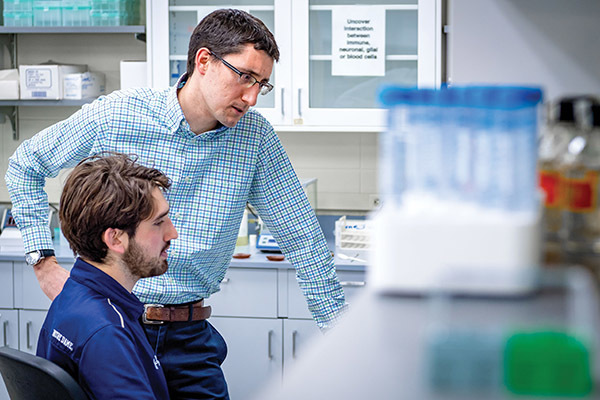 Smith’s team uses CRISPR on zebrafish to study how a single fertilized egg transforms into the millions of specialized cells that comprise a fully functioning neural network. Photo by Matt Cashore ’94
Smith’s team uses CRISPR on zebrafish to study how a single fertilized egg transforms into the millions of specialized cells that comprise a fully functioning neural network. Photo by Matt Cashore ’94
At their current rate of progress, the team expects to achieve a hybrid embryo by 2020. Ultimately, they hope to introduce their Pleistocene-ish mammals into the Siberian ecosystem and deploy mammoth-powered tundra modification — more grass, fewer trees and a lot more poop — to reverse the effects of climate change. First, however, they’ll have to figure out how to gestate that one-of-a-kind embryo in a synthetic uterus, hope that the resulting organism’s genome contains all it needs to survive in the modern biome, and figure out how to rear a once-wildly-sophisticated social creature in the absence of the intergenerational relationships that are central to pachyderm culture. In the meantime, the team has encountered the kind of serendipitous discoveries that emerge from basic research, including insights that could drive vaccine development for a hemorrhagic virus that is the leading cause of death among captive elephants in North America and Europe.
Basic biology
To get a better handle on how soon you might be able to book your family’s Jurassic Park-style adventure in Siberia, it helps to have a better handle on the underlying genetics. Your smartphone achieves its potential with strings of billions of 1s and 0s. DNA — the biochemical code for growth, development, functioning and reproduction nestled within every cell of every living organism — performs vastly more complex operations with a quaternary code comprised of the macromolecules adenine, thymine, cytosine and guanine (A, T, C and G, for short).
You’ve seen the double helix, that spiraled ladder of genetic inheritance celebrated with the 1962 Nobel Prize? The ladder rungs represent chemical bonds spanning those macromolecules — always A paired to T, C paired to G. The human genome boasts more than 3 billion base pairs. Epstein-Barr, the virus that causes mononucleosis, has a measly 172,000. Beginning in 1976 with MS2, a virus that infects E. coli, scientists have detailed the unique sequences of ATCG in a wide variety of organisms, all part of the quest to understand how those four molecules collectively orchestrate biological function.
Whether making a baby or assembling a protein to carry messages among cells, DNA is the master of genetic ceremonies: The double helix unwinds and an enzyme races up the middle, breaking the rungs like a pull-tab opening a zipper. To create a duplicate strand of DNA — as when your body generates new cells after a blood donation or an embryo grows during gestation — enzymes summon more ATCG to mirror the unzipped strands, yielding two identical copies. To build the proteins that cross cell membranes and carry messages throughout the organism, an unzipped strand of DNA generates RNA, which assembles the component amino acids.
Either way, DNA moves fast, making errors inevitable. External forces, like radiation or chemical exposures, may also reduce fidelity. Not surprisingly, then, all living organisms have a toolkit dedicated to DNA quality control. If the damage is extensive, a cell might self-destruct or turn cancerous. But when the ladder snaps — what scientists call a double-stranded break — sometimes the damage can be fixed. If they fit, the two ends of a strand can be fused back together. Or, if the frayed ends aren’t a perfect match, a patch of DNA might be spliced into the gap. Sometimes those repairs are imperceptible, and sometimes the underlying order of ATCG gets a bit scrambled in the process, causing a genetic mutation.
The poster and the scalpel
Just like the ecological web of life we can see with our naked eyes, the organisms within the microbial world exist in a complex network of relationships. Humans have an entire immune system dedicated to distinguishing self and other, protecting our own DNA while fighting off infections from foreign DNA. Bacteria have CRISPR for the same purpose.
Unlike eukaryotic organisms — everything from yeast to grass to human beings — whose cells have a dedicated nucleus in which to contain their DNA, unicellular prokaryotes like bacteria just cram their DNA in a corner and hope for the best. That casual approach makes contamination with foreign DNA a constant hazard. And so bacteria assemble the microbial equivalent of the wanted posters on a post-office wall. The poster “images” are composed of snippets of foreign genetic material; molecular spacers serve as borders. Scientists know the combination as Clustered Regularly Interspaced Short Palindromic Repeats. CRISPR, for short.
Using CRISPR, a bacterium doesn’t have to do a full-scale threat assessment of every strand of genetic material within its cell walls. Instead, it deploys CRISPR and a collection of CRISPR-associated proteins (Cas, for short) to scan the wanted posters for a match. If the system identifies a pathogen, the Cas works like a precision scalpel to induce double-stranded breaks — creating short, step-stool-like chunks of the invader’s DNA that match the CRISPR sequences.
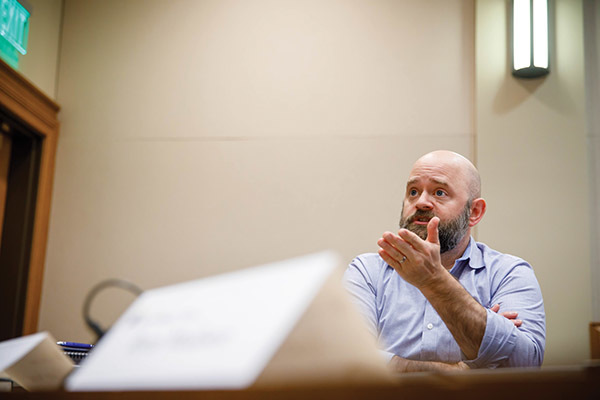 Snead: “The major defect of self-regulation by any group of practitioners is that their momentum and enthusiasm offer no constraint, no external regulation.” Photo by Peter Ringenberg
Snead: “The major defect of self-regulation by any group of practitioners is that their momentum and enthusiasm offer no constraint, no external regulation.” Photo by Peter Ringenberg
Researchers’ understanding of CRISPR in its prokaryotic environs had been gathering steam for nearly two decades when a team at the University of California, Berkeley announced that it had harnessed CRISPR to introduce double-stranded breaks at pre-determined locations. First, they made their own CRISPR — a fabricated wanted poster for the precise sequence of ATCG they meant to alter. Then they combined their CRISPR with each of several naturally occurring Cas proteins, assessing which combination was most effective. In August 2012, they reported in Science that CRISPR-Cas9 had allowed them to precisely target DNA and snip it to pieces. Six months later, a team in Boston used CRISPR-Cas9 in mouse and human cells to introduce double-stranded breaks within eukaryotic cells and to guide the repair system and tailor the resulting mutations.
The innovation was a game-changer, says Champion, the bacteriologist. Scientists had long had tools for effectively and efficiently manipulating prokaryotic DNA without killing the associated organism in the process. Eukaryotic gene editing had been a much more complicated effort. In the six years since those first attempts to harness the new technology, scientists around the world have published more than 5,000 papers detailing their own CRISPR-powered discoveries in bacteria, yeast, food crops and a Noah’s Ark of critters like Cody Smith’s zebrafish. In addition to refining the technical process for introducing targeted breaks, they’ve figured out how to splice in multiple genes in a single operation — as with the woolly mammoth project.
Given the fundamental questions he wants to answer, Smith has kept things relatively simple. He wants to know how small snippets of ATCG within a single gene affect the cascade of signaling among nerve cells during development. Instead of messing around with gene splices, Smith chooses where to induce the double-stranded DNA break, then lets the zebrafish’s own DNA quality-control system take over. By comparing and contrasting how the mechanisms of neural development are affected by the resulting mutations, he can identify how specific regions of code orchestrate normal or atypical development.
In order to conduct experiments worth publishing, Smith needs entire populations of identically mutated zebrafish. He could alter fish eggs and sperm, but it’s more efficient for his purposes to focus instead on the next step in development — the DNA pooled in the fertilized egg. Since he joined the Notre Dame faculty in 2016, Smith and his students have used CRISPR to mutate thousands of zebrafish zygotes, sequenced the base pairs of dozens of CRISPR-mutated neural genes that might have qualities worthy of further investigation, and bred five distinct colonies of fish. “Everybody in my lab has their hands on something related to CRISPR,” says the professor, who engineers the CRISPR that guides the mutation process and buys a version of Cas9 commercially engineered for use in zebrafish. His undergraduate research assistants scoop fertile eggs from the bottom of the lab’s dedicated breeding tanks and use a needle with a gauge finer than a human hair to inject the nucleus of each embryo with the CRISPR-Cas9 compound.
The goal is to achieve a mutation replicated in every cell in the mature zebrafish, including the germline cells that pass the mutation on to its offspring. That means Smith and his team have to keep an eye on the clock: From the moment that sperm fertilizes egg in the breeding tank, they have 30 minutes before the embryo starts dividing and differentiating into the cells that will become the digestive system, spinal cord, scales, and so-forth of the adult zebrafish. The CRISPR-induced double-stranded breaks and the resulting, mutation-inducing DNA repair process can take a good bit longer. As a result, cell division and replication often outpaces the DNA quality-control system to create what geneticists know as mosaics — creatures in which some cells exhibit a particular mutation and others don’t. Smith’s three grad students monitor the CRISPR’d fish as they mature, selecting individuals with a pure genotype that includes neurological mutations of interest and overseeing the process of breeding a stable population on which to conduct a given experiment. “It takes a little over six months,” says Smith, “if you’re hitting it spot-on.”
Despite the existence of CRISPR kits that help home brewers engineer yeast to produce glow-in-the-dark beer, the technology has a long way to go before it’s ready for the plug-and-play editing of multicellular organisms that have comparatively intricate physiology and function. Whether making a mashup of Asian elephant and woolly mammoth DNA, tinkering with the neural system of a short-lived zebrafish or lab rat, or unraveling the role of a gene implicated in congenital heart defects in human embryos, scientists have a lot to learn about how to introduce mutations, reduce off-target revisions and limit the mortality rates associated with such tampering.
Staying on target
When Patricia Champion teaches her course on medical molecular genetics, she covers CRISPR’s origins, how it works in different organisms, and its potential clinical applications. She also digs into some of the technology’s shortcomings. Perhaps most significant, as an automated system without an “off” switch, CRISPR can get a little ahead of itself, initiating changes not only to specified sequences, but also to nearly identical sequences of ATCG in nearby genes that weren’t meant to be modified.
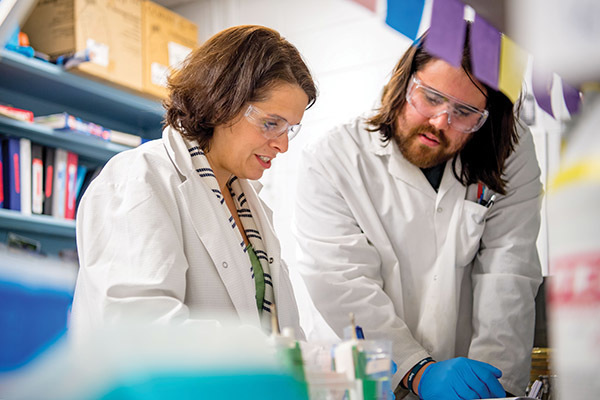 Champion: “CRISPR doesn’t work in every organism, and sometimes when it does work in an organism it does a lot of off-target things.” Photo by Matt Cashore ’94
Champion: “CRISPR doesn’t work in every organism, and sometimes when it does work in an organism it does a lot of off-target things.” Photo by Matt Cashore ’94
“CRISPR doesn’t work in every organism, and sometimes when it does work in an organism it does a lot of off-target things,” Champion says. Missing the mark is a significant concern for basic scientists who are intent on creating only the bare minimum of research animals and producing reliable data. It is all the more worrisome in the context of human applications. What if, for instance, that off-target effect introduces a glitch in the human tumor suppressor gene, or alters the proteins that convey data from the peripheral nervous system to the spine?
In her inquiries into tuberculosis — based on Mycobacterium marinum, which causes the fish version of the disease — Champion still relies on older, more established techniques for molecular engineering and gene editing. “Since we have a very easy way to make changes to the M. marinum genome that doesn’t require CRISPR, we haven’t used it,” says Champion, a faculty member of both the Boler-Parseghian Center for Rare and Neglected Diseases (CRND) and the Eck Institute for Global Health.
But at the rate the technology is developing, it’s only a matter of time before she adds the technology to her own lab’s toolkit. “I think CRISPR is amazing,” she says. “We would totally go there.”
Xin Lu already has. A member of both the CRND and the Harper Cancer Research Institute, Lu is a cancer immunologist digging into the biochemical pathways that give rise to metastasis. “The real cause of cancer death is not the primary tumor,” he says, “but the spread of the cancer to vital organs like the liver, bones. That’s what kills the patient.”
Lu uses CRISPR to engineer mice whose genes have been modified to alter their immune response to cancer. “It’s not that we could never do that before,” he says. “There were techniques, but they were way more complicated.” With CRISPR, he says, a first-year graduate student can purchase the reagents and in a month produce the knockout cells to run an in vitro experiment, laying the groundwork for in vivo research that reveals how such knockout cells function in a living organism.
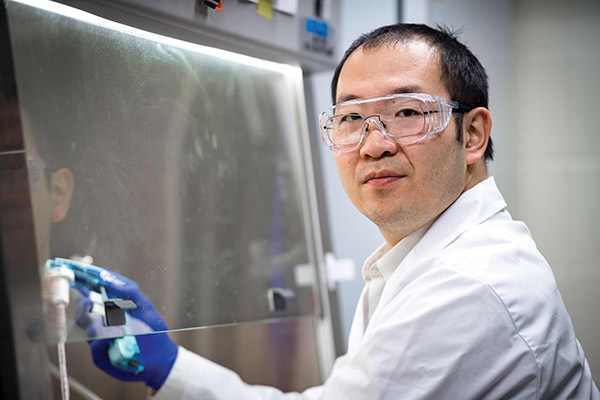 Lu: “We know that a lot of rare cancers are caused by a simple mutation, but since they’re rarely studied, we don’t know how to treat them.” Photo by Matt Cashore ’94
Lu: “We know that a lot of rare cancers are caused by a simple mutation, but since they’re rarely studied, we don’t know how to treat them.” Photo by Matt Cashore ’94
That combination of efficiency, affordability and accuracy is especially attractive to junior faculty like Lu and Smith, who are scrambling to amass the pilot data they need to garner the awards and grants on which senior investigators like Champion rely. And in the perennially cash-strapped world of rare-disease research, where small patient populations typically fail to attract the interest of moneyed investors, CRISPR may enable breakthroughs long considered out of reach. “We know that a lot of rare cancers are caused by a single mutation,” says Lu. “But since they’re rarely studied, we don’t know how to treat them, how to manage the disease.”
It might work to simply un-mutate the offending gene, he says. So, in addition to creating animal models that mirror single-gene cancers like sarcoma, he and his team are experimenting with new ways of delivering CRISPR to correct those mutations in a multicellular organism. Says Lu: “This could offer new hope for the rare-cancer patient.”
Already, CRISPR has infused malaria research with fresh possibility. Spurred by drug resistance and the complexity of the ecological relationships among mosquitoes, the physical environment and humans, malaria exacts a $12 billion toll every year in the primarily poor, tropical and subtropical countries where it is endemic. CRISPR promises public health visionaries a wealth of new leverage points, including the possibility of engineering mosquitoes both resistant to malaria and more reproductively successful than their wild-type mates, and even the possibility of rendering mosquitoes sterile in a bid to wipe target mosquito species from the face of the earth. If scientists could effectively eliminate the vector between the protozoan that causes malaria and its human host — without a single puff of toxic insecticide — millions could be spared a debilitating and often deadly disease.
Hard questions
The trick, of course, is not opening Pandora’s box in the process. “If you want to be frightened, talk to a biosecurity expert about what happens if a genetically modified mosquito escapes the lab,” says Snead, the bioethicist, invoking the fundamental uncertainty about unintended consequences that has fueled debates over genetically modified organisms since the 1980s.
Snead sits on two scientific working groups grappling with the ethics of CRISPR. One is led by Jennifer Doudna, the University of California, Berkeley, scientist who co-authored the 2012 Science paper on CRISPR-Cas9. The other includes among its members George Church, the Harvard and MIT geneticist who leads the woolly mammoth project.
Scientists have a responsibility to confront the ethical conundrums their work raises, but the general public has a duty to shape those conversations, says Snead — especially in the case of CRISPR, where billions of dollars are at stake, billions of lives could be affected, and the science is moving so fast that the scientists themselves can barely keep up.
“The major defect of self-regulation by any group of practitioners is that their momentum and enthusiasm offer no constraint, no external regulation,” Snead says. “The very bodies being regulated rise in influence and power to become overlords of the regulators, or regulators themselves — like when the oil industry gains a foothold in environmental regulation.”
By inviting non-scientists to grapple with the implications of gene-editing technology, Pope Francis has done the lay public a great service, says Baron, the science historian. In addition to calling out CRISPR as a topic for discussion, the Pope has highlighted the differences between the somatic gene edits that might, for example, promote better pancreatic function in a person with diabetes, and those alterations to embryonic cells — paired with in vitro fertilization — that could eliminate diseases like Tay-Sachs or Huntington’s from the human genome.
“The Church is doing us all a bit of a favor right now in teaching people the difference” between somatic cell gene editing on the one hand and germline editing on the other, says Baron. “I’m all for people having a more nuanced view of new technologies. And, frankly, we can be pretty sloppy about the way we describe things, such as cells and embryos. Theologians commenting on technology have to make those distinctions, and that helps us all understand things better, even if we don’t agree on what should be done.”
Expect such debates to be especially fierce around the prospect of edits to the human germline, says Snead. Whether done in pursuit of a designer baby with a stratospheric IQ and the chops to play Rachmaninoff, or as a workaround for a familial predisposition to breast cancer or Huntington’s, extensive basic research on human embryos will necessarily precede any clinically approved therapies. And that makes it easy to get bogged down in pro-life culture wars, says Snead, who served as general counsel to President George W. Bush’s Council on Bioethics, which tackled questions of embryonic and adult stem-cell research. “It’s a very old conversation, one we’ve been arguing for a long time. The thing grinds to a halt and you very quickly drill down to the fundamental disagreement over the use and destruction of human embryos. There’s not very much more to say.”
But humanity can’t afford to lose sight of the bigger picture, he says. CRISPR may be cheaper and faster than previous genetic engineering techniques, and it’s already yielding vital insights into disease processes that could drive new therapies, but it will still take millions of dollars in basic, taxpayer-funded research and clinical trials before your oncologist has a viable CRISPR therapeutic to offer instead of chemotherapy. Meanwhile, public health interventions such as access to clean water, healthy food and basic preventive services like vaccinations have the proven, cost-effective potential to improve the quality of life of millions of people right now. How does the return on investment in CRISPR-based healthcare stack up?
Malaria, which killed more than 400,000 people in 2016, might seem a more straightforward problem for CRISPR to solve. What cruel soul would campaign to preserve it for its own sake — or to save mosquitoes, for that matter — if it could be eliminated? Yet deeper questions linger, Snead says. Do we understand so fully the role of the mosquito in the ecosystem that we would be content to modify its genome and not only suffer the consequences ourselves, but visit them upon the natural world, snipping a species out of the web of life in which it exists?
Given the long-standing commercial interests in gene editing in agriculture, CRISPR has made quick inroads, with research underway to genetically enhance disease resistance in cattle and optimize muscle and fat ratios in hogs. The first CRISPR-engineered crop — a strain of corn from DuPont Pioneer with enhanced waxiness that makes it especially desirable for paper adhesives and food thickeners — is slated to hit the market in 2020; CRISPR canola, cotton and tomatoes aren’t far behind. In addition to questions about unintended consequences in the agricultural gene pool and the larger ecosystem, such projects exacerbate long-standing tensions over patent rights and farmers’ freedom to save breeding stock, the role of government in evaluating and regulating the food supply and society’s interest in affordable, nutritionally dense food.
This semester, Snead took a leave of absence from his post at the Center for Ethics and Culture to develop a theoretical framework for tackling such fraught questions in public policy and bioethics. As he sees it, much of the debate boils down to competing claims about human identity and human flourishing. Do humans flourish if we more fully understand the roots of disease? If all heritable disorders have been eliminated? If genes can be patented and controlled by corporations? If we gain the power to reintroduce once-extinct species while hastening the extinction of others? And, should human germline editing come to pass, who is the human patient? Is it the parent electing the procedure, or the resulting generations whose genes will have been altered without their consent? CRISPR has already moved humanity one step closer to mapping our own fate. At the rate the field is advancing, there’s no time to waste formulating our vision for that future.
Sharon Tregaskis reported this magazine’s spring 2017 cover story on the future of the family farm; when she’s not translating the work of scientific and medical discovery for non-scientists, she pursues her own agricultural ambitions in central New York.
